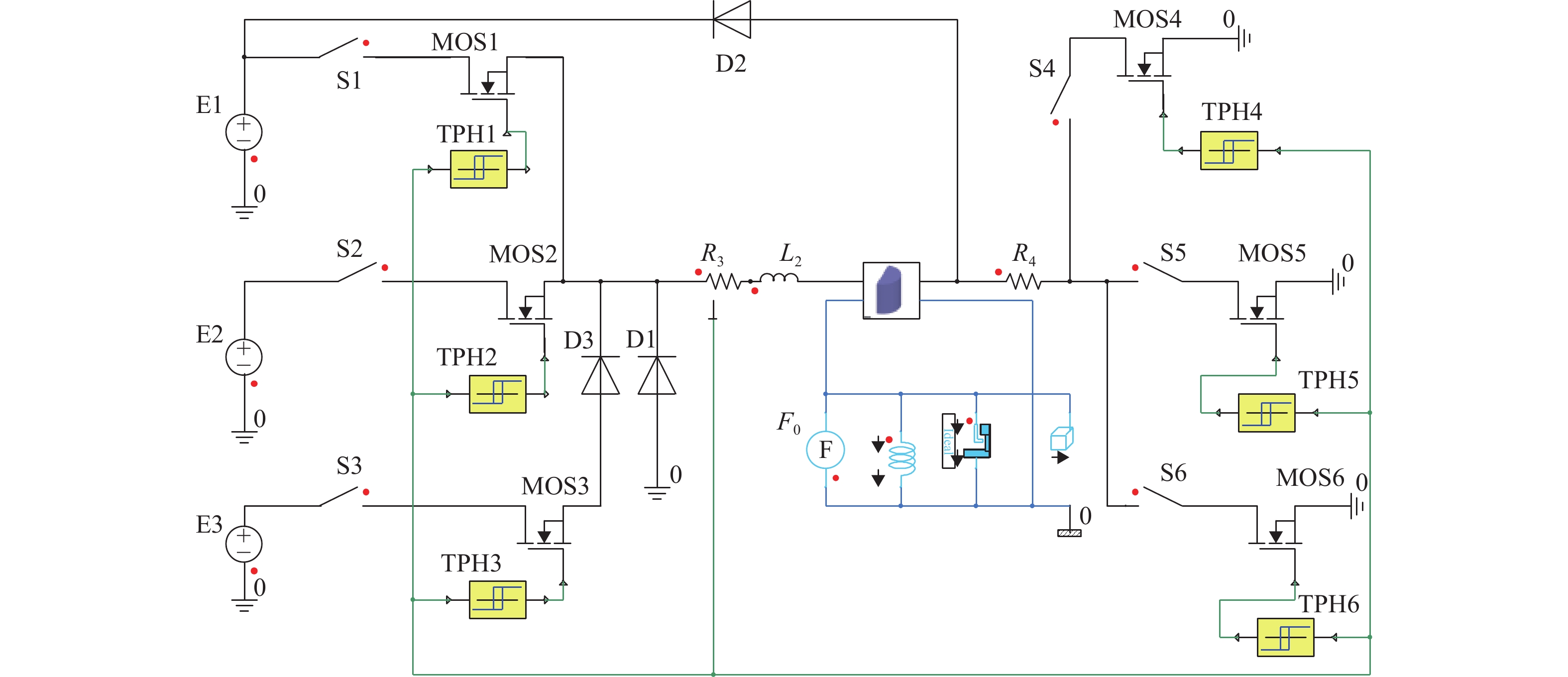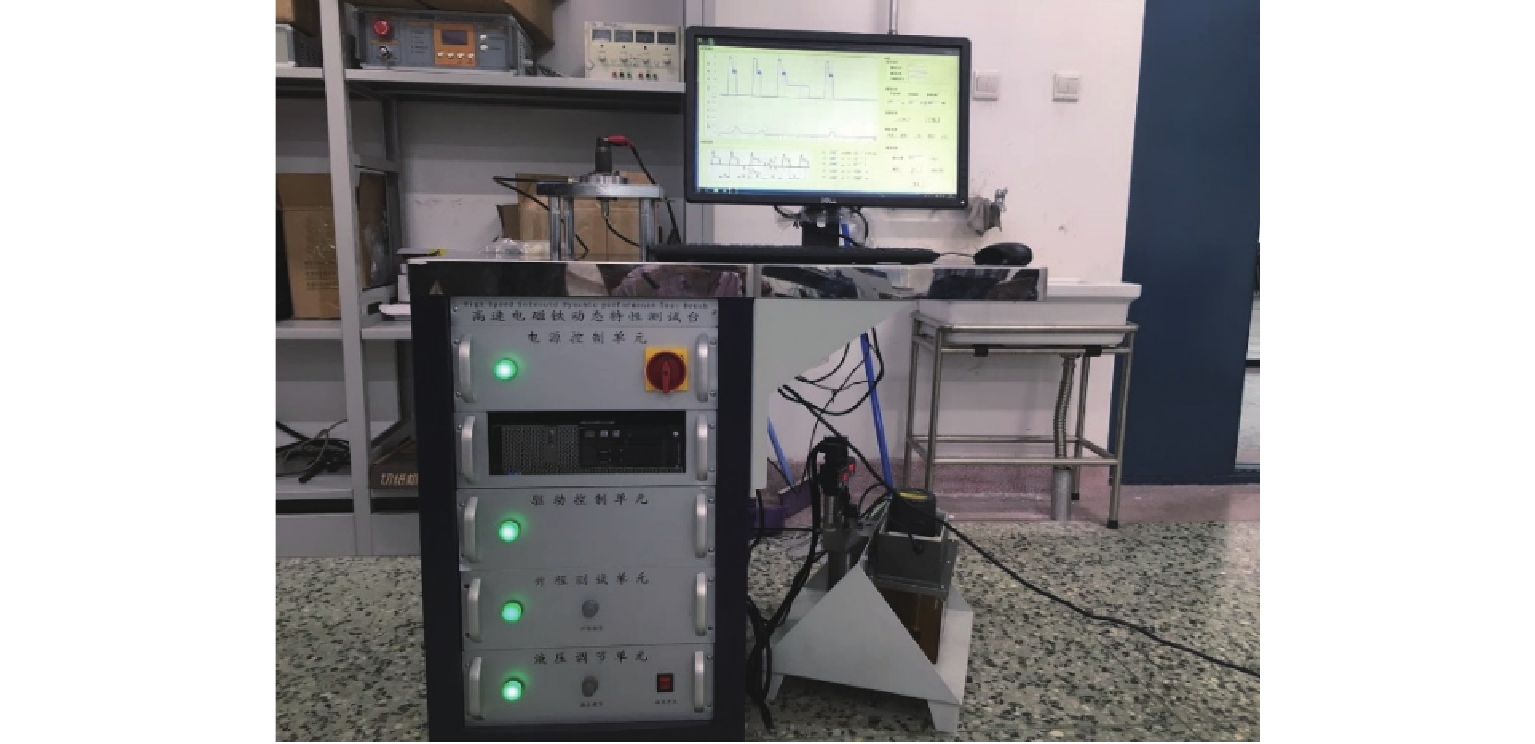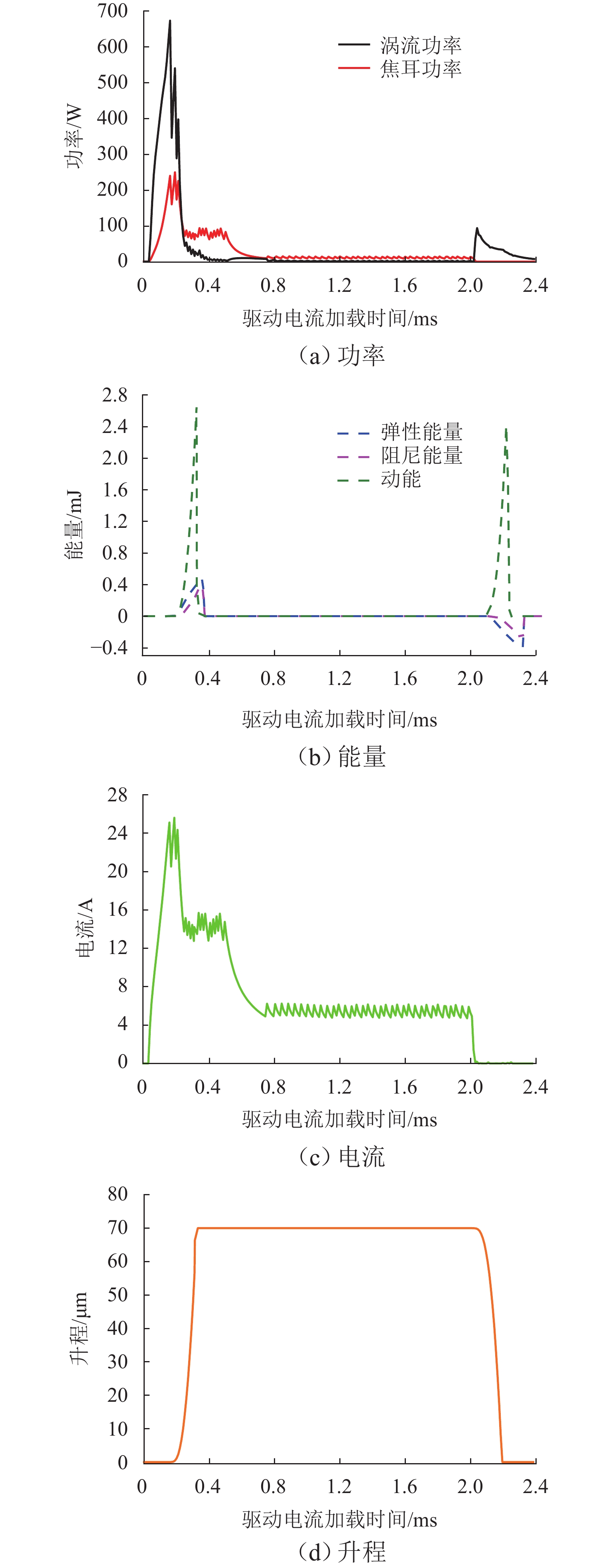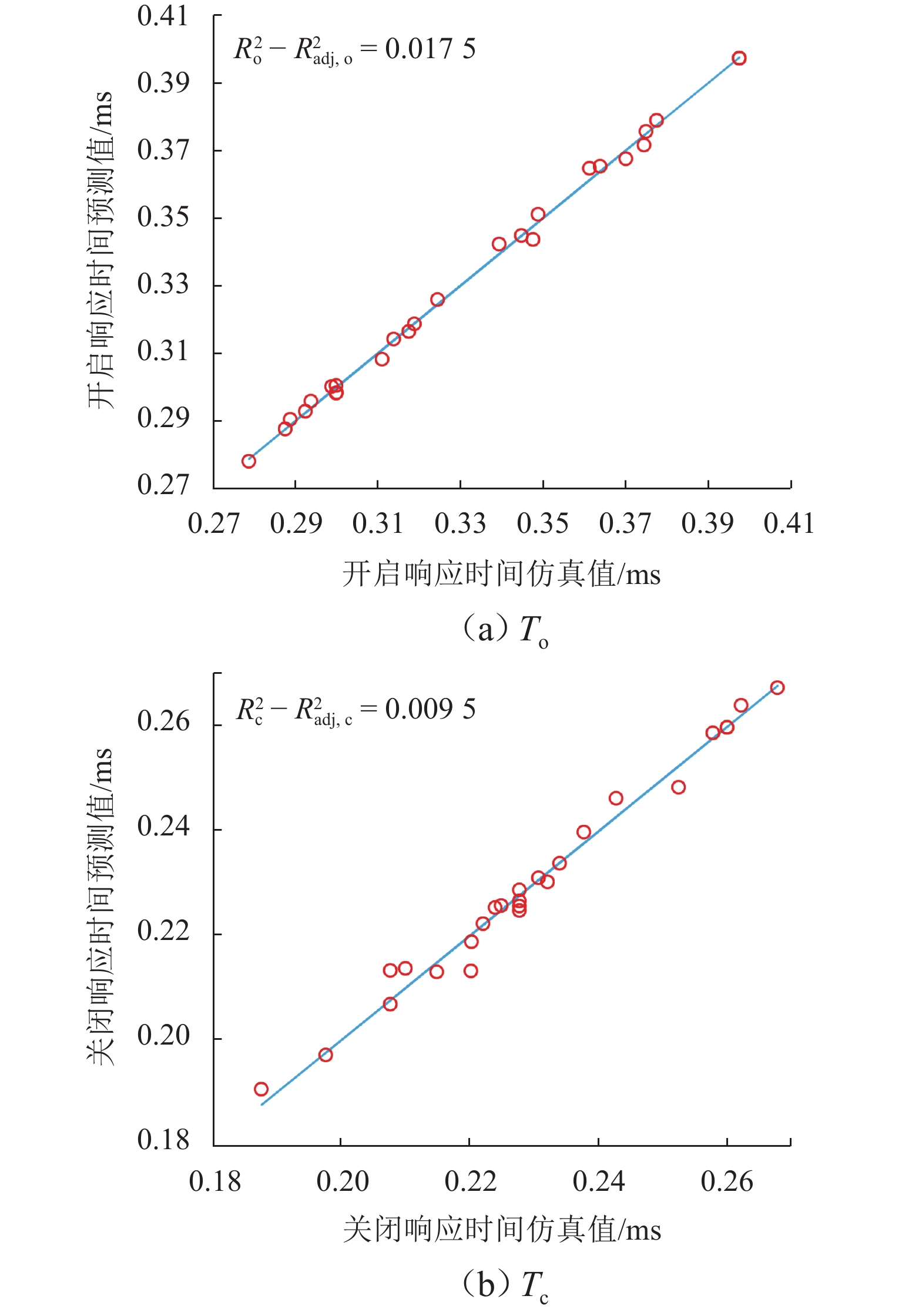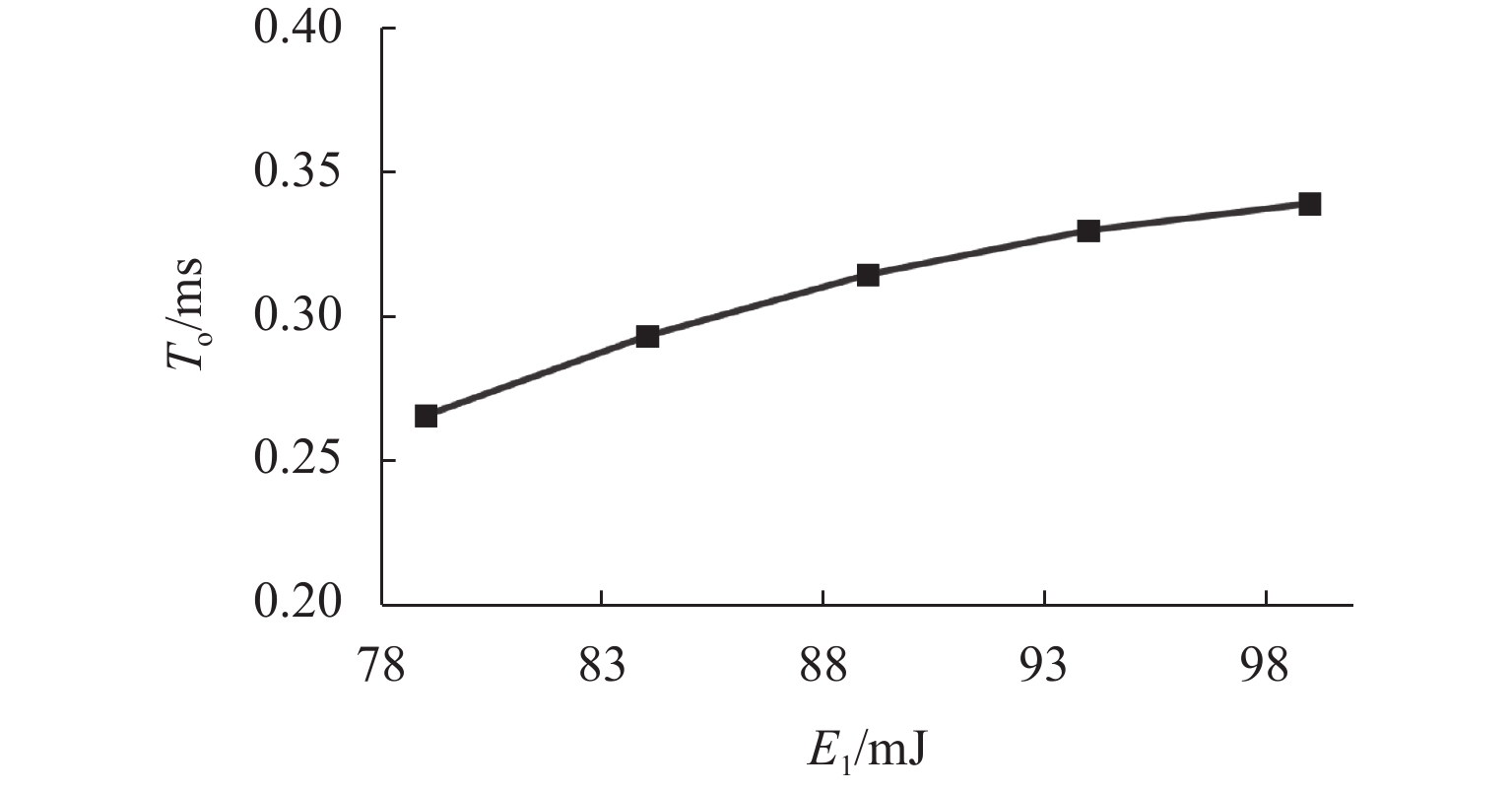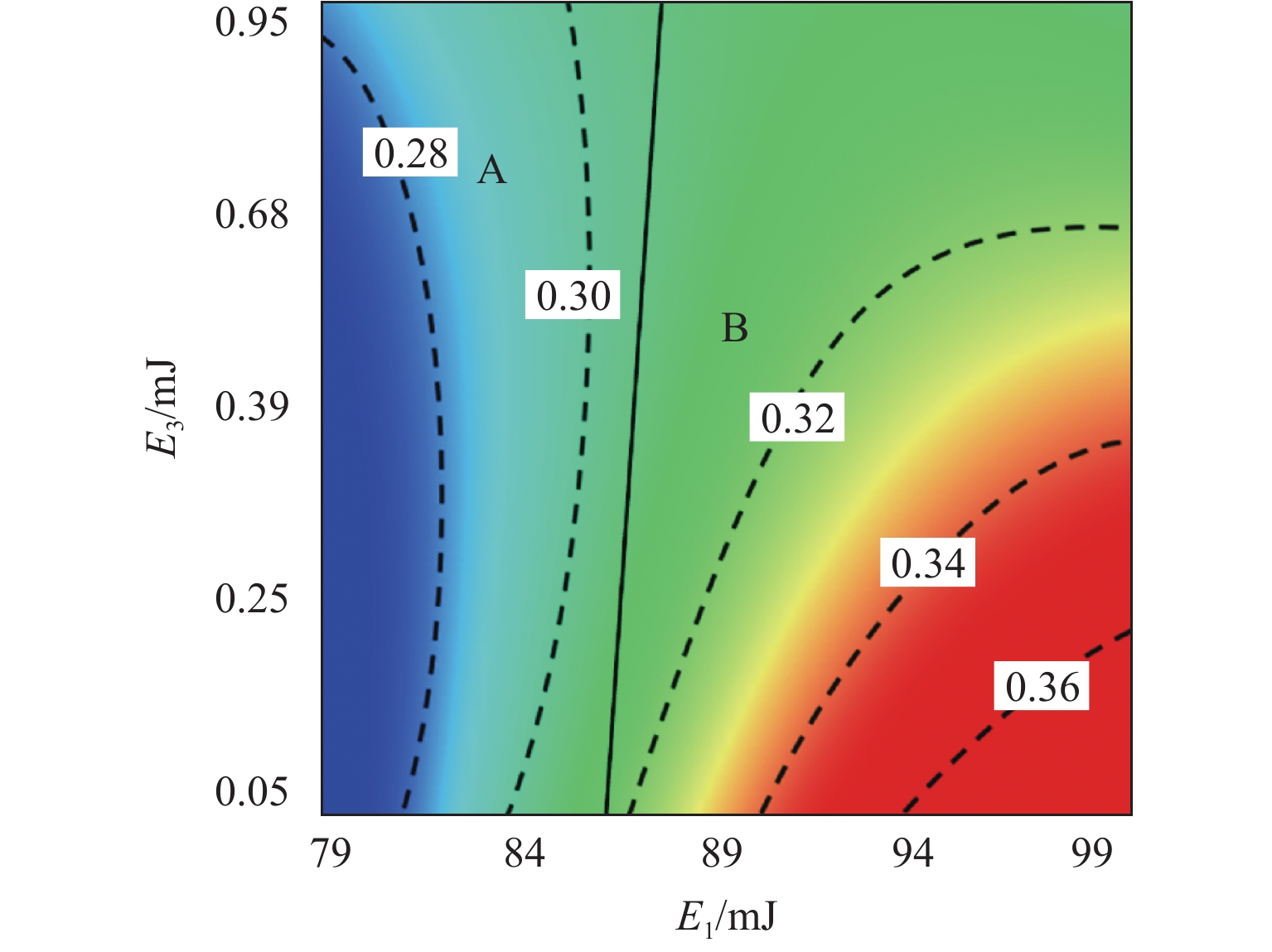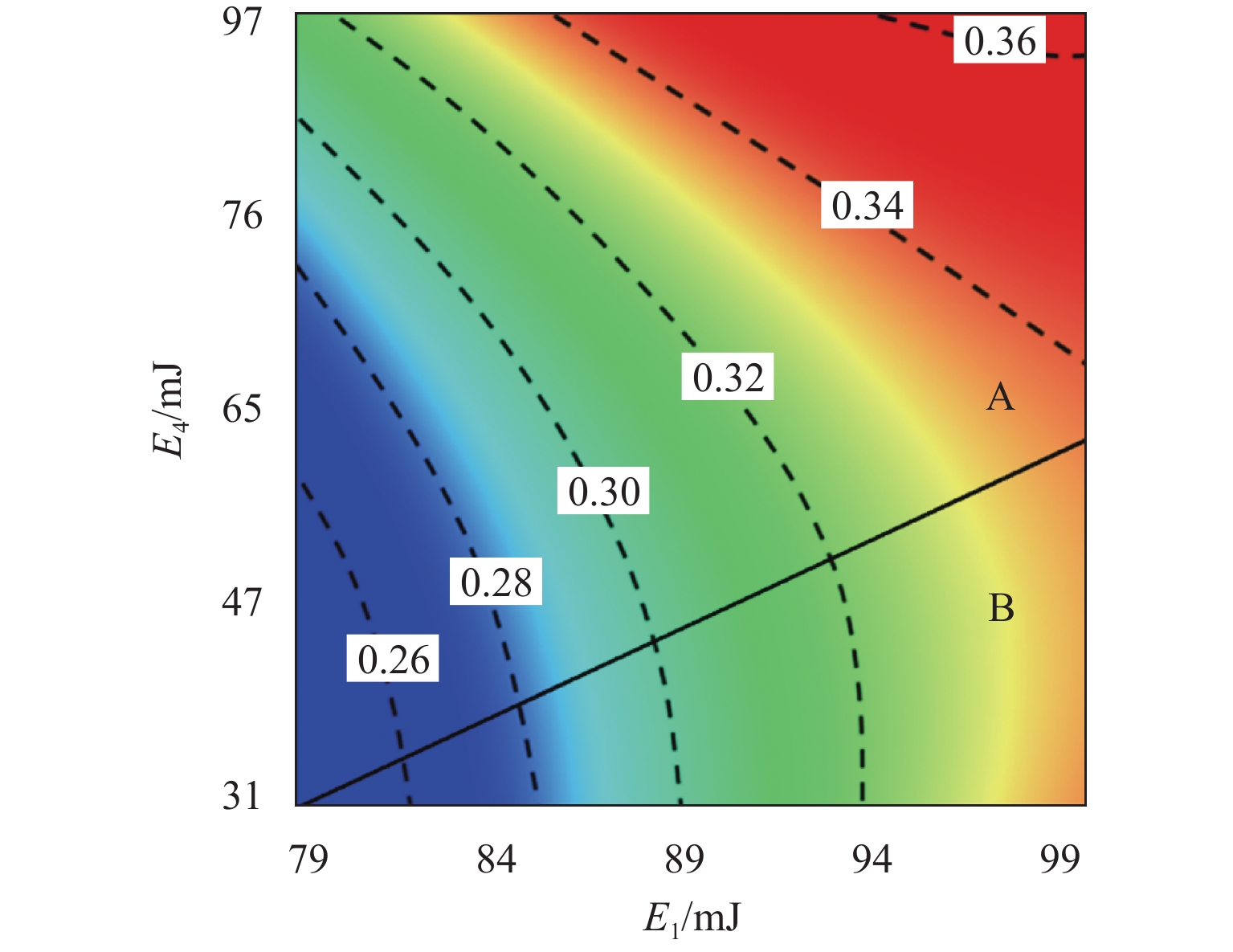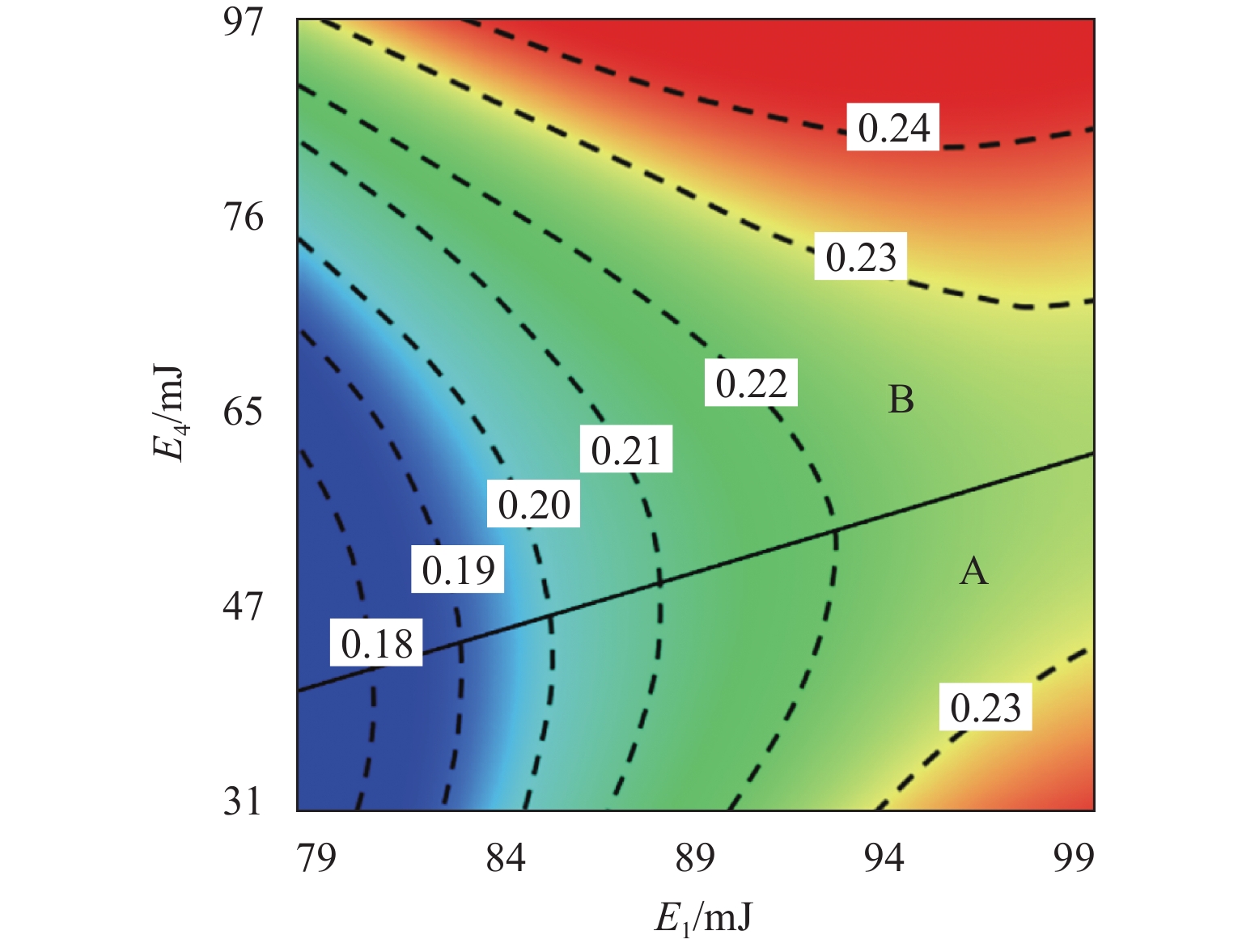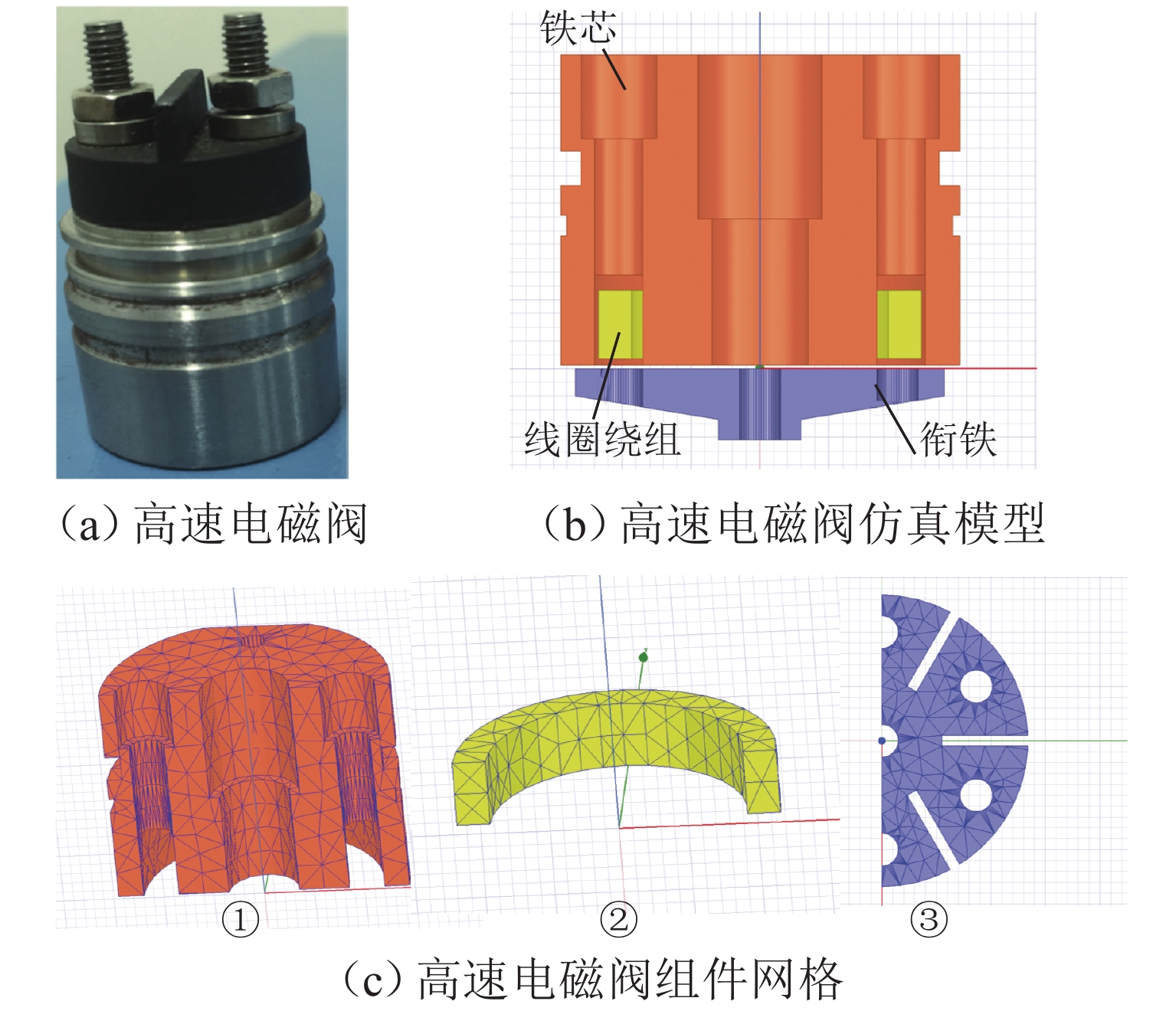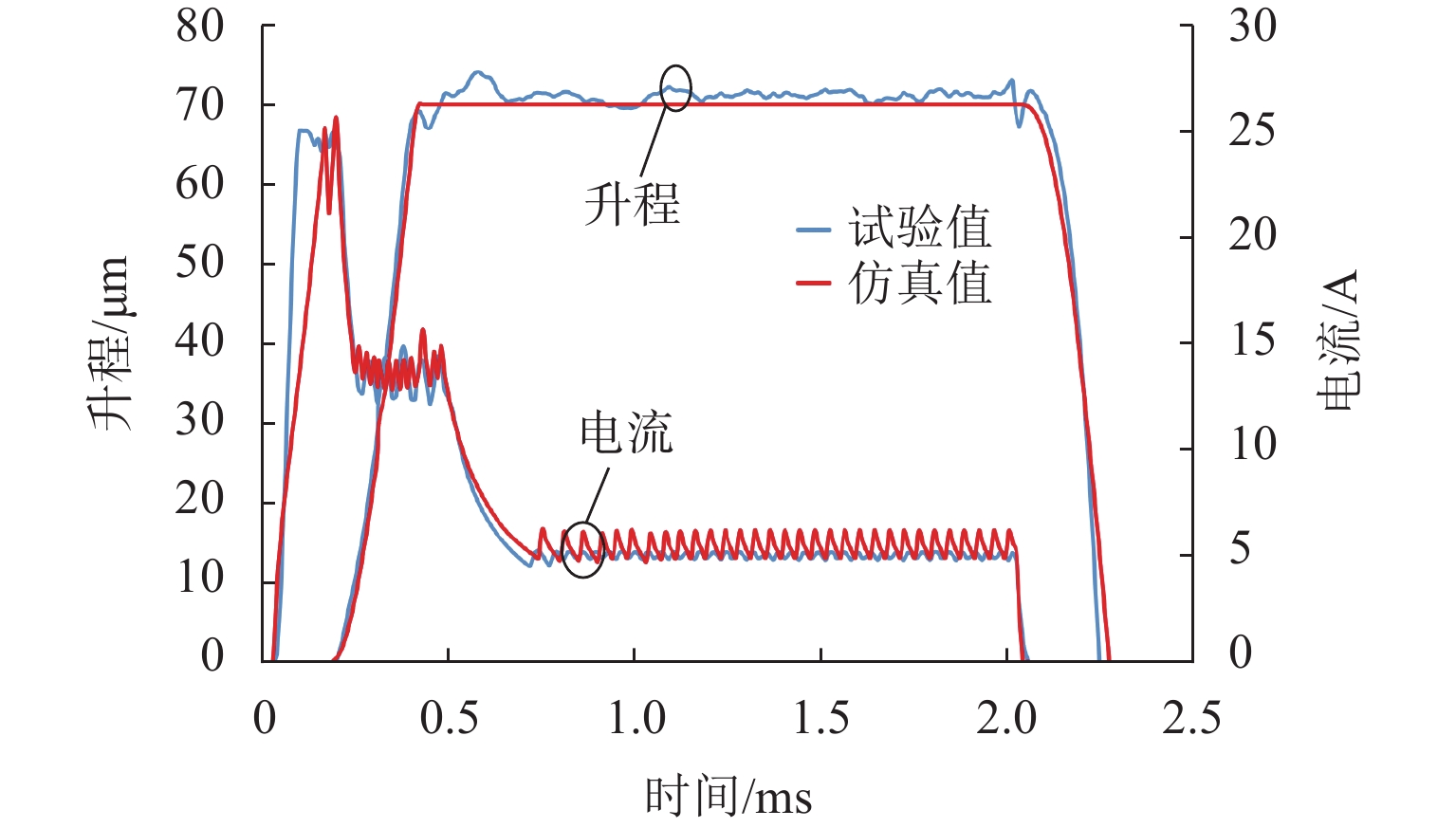Simulation Research on Coupling Relationship Between Energy Distribution and Dynamic Response of High-Speed Solenoid Valves
-
摘要:
为研究高速电磁阀内部的能量分布及能量参数与动态响应之间的耦合关系,对高速电磁阀性能进行优化. 首先,基于有限元法建立高速电磁阀动态模型,并通过实验数据验证模型的准确性;其次,利用D最优实验设计方法和最小二乘法,构建以能量参数为因素的电磁阀动态响应特性响应面预测模型;最后,使用元效应分析法开展了高速电磁阀动态响应显著能量参数及参数交互作用的仿真分析. 研究结果表明:单参数中涡流能量
E 1是影响高速电磁阀开启响应时间T o的较敏感参数,T o随着E 1的增加相应地增加了约25%,涡流能量分别与阻尼能量(E 3)和焦耳能量(E 4)之间的交互是影响T o的高敏感参数,同时涡流能量与焦耳能量之间的交互也是影响关闭响应时间T c的高敏感参数;交互参数中起主导作用的因素会随取值范围而改变.Abstract:In order to study the energy distribution inside the high-speed solenoid valve and the coupling relationship between the energy parameters and the dynamic response, the performance of the high-speed solenoid valve was optimized. Firstly, the dynamic model of the high-speed solenoid valve was established based on the finite element method, and the accuracy of the model was validated through the experimental data. Secondly, based on the D-optimal design of experiments and the method of least squares, the response surface prediction model of the solenoid valve’s dynamic response characteristics was constructed, with the energy parameters as the factors. Finally, based on the meta-analysis method, the simulation analysis of the dynamic response of the high-speed solenoid valve with significant energy parameters and parameter interactions was carried out. The results show that the eddy energy
E 1 is the relatively sensitive parameter affecting the response time of high-speed solenoid valve openingT o among the single parameters, andT o increases by about 25% with the increase inE 1. The interaction betweenE 1 and damping energyE 3 and betweenE 1 and Joule energyE 4 is the highly sensitive parameter affectingT o, and the interaction betweenE 1 andE 4 is the highly sensitive parameter affecting the response time of closingT c. The results also find that the factors that play a dominant role in the interaction parameters change with the range of values.-
Key words:
- solenoid valve /
- energy distribution /
- dynamic response /
- response surface method /
- significant factors
-
高速电磁阀(HSV)是动力机械装置燃气、燃油喷射系统的核心控制部件,控制系统通过对高速电磁阀的控制实现对燃气、燃油的喷射时刻和喷气量的精确柔性控制. 因此,国内外学者在高速电磁阀动态响应方面开展了较多的实验和仿真研究.
Gu等[1]基于试验设计方法,开展了影响电磁阀响应延迟的关键参数的研究,采用NSGA-Ⅱ遗传算法建立高速电磁阀多目标优化模型,优化电磁阀的响应延迟时间,实现电磁阀关闭延迟时间降低6%,开启延迟时间降低17.7%. Tao等[2]在考虑软磁材料特性对电磁阀性能影响的前提下,提出电磁阀磁场优化设计方法,最终实现电磁阀更大的电磁力和更低的功率消耗. Wang等[3]开发出新型高磁导率的Al-Fe软磁材料,为实现电磁阀的高动态响应特性,设计并优化了电磁阀的磁路结构. Sun等[4]研究驱动电流、磁极面积和线圈匝数等参数对高速电磁阀静态电磁力的影响,通过平衡主/副磁极横截面积,增大线圈匝数,减小工作气隙等技术方案,有效提高了电磁阀的电磁力;Zhao等[5]分析电磁阀在不同升压电压下的动态响应特性,证明存在最佳的升压电压以实现在电磁阀动态响应和有效电磁能量转化率两者之间的最优;Breidi等[6]开展驱动策略对电磁阀动态响应影响的研究,优化峰值电流、保持电流和反向电流,最终确定驱动策略的最优参数;Ebrahimi等[7]开展了带有永磁体电磁阀特性的研究,分析结构参数对电磁阀电磁力的影响规律,提出了永磁-电磁组合的电磁阀优化设计方法.
已有的电磁阀研究工作主要集中在结构参数、驱动参数等对电磁阀电磁力和动态响应的影响. 然而,更多是追求高动态响应,而忽略电磁阀内部能量转化和损耗对动态响应的影响. 因此,本文针对高速电磁阀,开展瞬态打开和关闭过程中高速电磁阀内部能量的转化和分布研究,揭示能量分布和动态响应之间的耦合关系,为开展高响应、低能耗的高速电磁阀的研究起到一定的理论支撑作用.
1. HSV工作过程中能量介绍
高速电磁阀由铁芯、衔铁、线圈绕组、预紧弹簧等部件组成,给电磁阀的励磁线圈通电后,在由磁性材料制成的铁芯和衔铁内部产生磁感应强度,当在电磁铁和衔铁之间产生向上的电磁力大于弹簧预紧力后,衔铁开始向上运动. 在切断电磁阀线圈内的电流后,电磁铁和衔铁间的电磁力逐渐减小,当压在衔铁上的弹簧预紧力大于衔铁向上的电磁力后,衔铁开始从最大升程位置回落,直到落座到电磁阀阀座.
在高速电磁阀工作过程中,外界磁场的快速变化在闭合回路中产生感应电动势,进而产生感应涡流,感应涡流形成的能量称为涡流能量E1,如式(1).
E1=∫t0Ceddyf2B2md2ρdt, (1) 式中:Ceddy为涡流系数,f为磁场频率,Bm为饱和磁感应强度,d为铁芯的壁厚,ρ为材料的电阻率,t为时间.
高速电磁阀在工作过程中,衔铁克服弹簧力开始向上运动,弹簧被压缩后形成的弹性能量E2为
E2=∫x0kxdx=12kx2, (2) 式中:k为弹簧刚度,x为高速电磁阀行程.
衔铁在运动过程中,衔铁与套筒存在一定的摩擦力,衔铁运动过程中形成的阻尼能量E3为
E3=∫x0BVddx, (3) 式中:Vd为衔铁运动速度,B为阻尼系数.
在高速电磁阀工作过程中,线圈绕组存在一定的电阻,电阻在电流的作用下会消耗一定的能量,该能量会转化为热,定义电阻产生的损耗能量为焦耳能量E4,如式(4).
E4=∫t0i2Rdt, (4) 式中:i为线圈电流,R为线圈绕组电阻.
在高速电磁阀工作过程中对开启、关闭响应时间起着决定性作用的是动能,高速电磁阀的动能越大,打开的速度越快,响应时间越小,动能E5定义为
E5=∫t0fexdt, (5) 式中:fe为高速电磁阀的电磁力.
2. HSV动态响应模型构建及校核
2.1 仿真模型构建
在进行高速电磁阀仿真模型建立时,本文作出以下简化和假设:1) 由于高速电磁阀为对称结构,选择对称的二分之一部分进行建模;2) 非磁性材料对仿真结果并不会造成影响,因此,只对铁芯、衔铁等磁性材料组成的部件和线圈进行建模;3) 衔铁和阀座为完全弹性碰撞,即不存在衔铁落座后的反弹. 高速电磁阀的最大间隙为0.12 mm,工作气隙为0.07 mm,线圈匝数为52匝,铁芯和衔铁的软磁材料为硅钢,弹簧预紧力为60 N.
图1所示为采用Ansoft Maxwell软件建立的高速电磁阀磁场三维模型.
为实现高速电磁阀更快地打开和关闭,通常采用peak-hold电流形式的驱动. 电流反馈驱动的工作过程为:在高速电磁阀打开阶段,供给高电压实现线圈内快速形成大的驱动电流,从而加快高速电磁阀电磁力的增加,实现高速电磁阀的快速打开;在高速电磁阀完全打开阶段,供给较小的保持电流,实现高速电磁阀稳定打开,较低的保持电流可以降低驱动电流的功率消耗,而且可以减小高速电磁阀线圈的发热量;在高速电磁阀关闭阶段,供给较大的负向电压加速高速电磁阀铁芯的快速退磁,以实现高速电磁阀更快地关闭[8].
三维电磁仿真软件Ansoft Maxwell带有驱动电磁执行器的驱动电路模块,但由于内置的电路模块较为简单,无法实现高速电磁阀的peak-hold电流反馈驱动电路的构建. Simplorer软件是一款用于设计和分析复杂电磁驱动的商业软件,可以根据真实电路过程构建复杂的电路驱动模型. 采用Simplorer软件建立的peak-hold电流反馈电路模型如图2所示,图中:E1~E3为电源,S1~S6为开关,MOS1~MOS6为功率开关,TPH1~TPH6为滞回比较器,D1~D3为二极管,L2为线圈电感,R3为线圈电阻,R4为采样电阻,F0为弹簧预紧力. 在peak电流阶段,S1、S4闭合,高电压源的驱动电压直接作用于电磁阀线圈上,电流从E1正极流出,流经开关S1、高速电磁阀、开关S4,最后接地,形成一个电流增加的闭合回路;在hold1保持电流阶段,E2作用在电磁阀上,形成E2—S2—电磁阀—S5—接地的电路;在hold2保持电流阶段,E3作用在电磁阀上,形成E3—S3—电磁阀—S6—接地的电路.
本文采用Ansoft Maxwell软件建立高速电磁阀详细磁路三维模型,采用Simplorer软件建立真实的电流反馈驱动电路,并在Simplorer平台进行驱动电路和磁路模型的耦合,从而实现高速电磁阀动态过程的仿真计算.
2.2 模型校核验证
为验证2.1节中构建的高速电磁阀动态响应计算模型,需要采用高速电磁阀衔铁升程实验数据进行校核. 图3所示为开展动态响应实验的高速电磁阀动态响应实验装置. 该实验装置由霍尔式位移传感器、电流驱动单元和数据采集单元组成,可以进行0~90 μm内位移和最大驱动电流25 A的高速电磁阀动态响应实验.
图4对比了在工作行程为70 μm下三维仿真计算的动态响应结果和实验数据. 从图4看到,计算的衔铁升程曲线和实验数据在衔铁抬起时刻、衔铁上升阶段、衔铁下降阶段均具有较好的吻合性,计算结果和实验数据之间的最大误差小于5%. 计算结果和实验数据的一致性证明本文建立的带有电流反馈的高速电磁阀动态响应计算模型的准确性,为后面开展高速电磁阀能量分布的研究提供精准的仿真模型.
3. 结果与讨论
3.1 HSV工作过程中能量分布研究
对于高速电磁阀来说,焦耳能量和涡流能量是过程量,采用功率进行描述,而弹性能量、阻尼能量和动能是状态量,和瞬时的时刻相关,故采用能量进行描述. 图5为在高速电磁阀一个工作循环内各种功率和能量随衔铁运动的变化规律. 从图5看到:在衔铁上升阶段,涡流功率迅速增大,在t=0.18 ms时,达到最大值660 W,之后涡流功率开始迅速减小;在t=2.00 ms时,功率又急剧增大到100 W,之后开始缓慢减小,涡流功率的变化和驱动电流的变化率紧密相关,涡流功率的产生总在驱动电流快速改变阶段出现,驱动电流变化越快,功率也随之越大;对于焦耳能量E4,是高速电磁阀生热的主要贡献者,焦耳功率的变化规律和驱动电流的变化规律是一致的,焦耳功率随驱动电流的增加而更大;弹性能量E2和阻尼能量E3随驱动电流加载时间的变化规律和衔铁的运动规律是一致的,在t=0.40 ms时,E2和E3分别达到最大值,从式(2)、(3)可以确定.
表1所示为高速电磁阀在不同阶段能量分布情况. 从表1中看到:1) 在高速电磁阀打开阶段,E1占比最大,达到为70.87%;对生热起到决定作用的E4占比为14.56%,排名第二;表征高速电磁阀开启响应时间的E5在全部能量中仅为8.27%,是E1的1/10;E2和E3的占比分别为3.93%和2.37%,其占比不到全部能量的5.00%. E1较大的占比极大制约高速电磁阀的快速打开,为实现高速电磁阀快速打开,需要降低E1. E1和E4是高速电磁阀温升的主要来源,为降低高速电磁阀的温升,需要尽量降低E4,从而提高电磁阀的工作可靠性和使用寿命. 2) 在高速电磁阀保持阶段E4占比为57.41%,占总能量的比例最大,会导致高速电磁阀在此阶段产生大量的热;与高速电磁阀打开阶段性相比,E1占比下降至25.53%,E2占比上升至17.06%,高速电磁阀在最大升程处保持不动,因此E3和E5消失. 3) 在高速电磁阀关闭阶段,由于不在给线圈提供驱动电流,E4下降至0,而E1占比为37.05%;动能E5占比增加至34.23%,与E1的占比十分接近;与高速电磁阀保持阶段相比,衔铁运动导致E2、E3再次产生,占比分别为19.03%、9.69%.
表 1 高速电磁阀不同阶段能量分布Table 1. Energy distribution of high-speed solenoid valves at different stages% 能量 打开阶段 保持阶段 关闭阶段 E1 70.87 57.41 37.05 E2 3.93 17.06 19.03 E3 2.37 25.53 9.69 E4 14.56 0 0 E5 8.27 0 34.23 3.2 HSV响应时间的响应面预测模型研究
响应面模型具有实验次数少、模型预测精度高和输出参数预测性好等优点,在工程研究中被广泛用于预测模型的构建研究[9]. 在本文中采用响应面预测模型构建高速电磁阀开启响应时间To和关闭响应时间Tc的预测模型. 响应面模型是基于三阶以下的线性多项式建立的[10],一阶多项式精度不够,预测误差较大,三阶多项式具有较高的精度,但计算迭代时间较长,综合考虑,选择二阶多项式进行响应面函数的构建,如式(6).
y=a0+4∑i=1aiXi+4∑i=1aiiXi2+4∑i=14∑j=i+1aijXiXj, (6) 式中:y为响应变量,a0为常数项,Xi为单项,Xi2为平方项,XiXj为二次交叉项,ai为单项系数,aii为平方项系数,aij为二次交叉项系数.
由式(1)~(4)可知,改变电导率、弹簧刚度、阻尼系数和电阻可实现对E1~E4等能量的改变,参数具体变化范围如表2所示. 在构建响应面模型时,需要进行计算矩阵的构建,本文采用正交试验方法,建立表3所示的28组计算参数,并采用上述校核过的高速电磁阀瞬态计算模型完成动态响应的计算,得到相应的To和Tc.
表 2 参数变化范围Table 2. Parameter variation range改变参数 基准值 变化范围 电导率/(S·mm−1) 2000 1400 ~2600 弹簧刚度/(N·mm−1) 57 47~67 阻尼系数/(N·(m·s−1)−1) 95 75~115 电阻/Ω 0.38 0.18~0.58 基于表3得到的不同能量下对应的To和Tc,采用遗传算法,结合二阶响应面函数(式(6))确定了高速电磁阀To、Tc的响应面预测函数分别为
To=f(E1,E2,E3,E4)=−1.37776+31.14076E1−6.18990E2+444.00291E3+1.75407E4−123.47484E21+246.27587E22+33939.69532E23+10.67849E24−38.89405E1E2−5400.01098E1E3−34.86095E1E4−955.52174E2E3+56.33425E2E4−208.89358E3E4, (7) Tc=f(E1,E2,E3,E4)=−1.17145+26.83757E1−2.03826E2+220.35482E3+1.17544E4−109.94943E21+521.46879E22−874.49014E23+16.98636E24−134.45779E1E2−1484.86052E1E3−35.30428E1E4−5975.23811E2E3+13.45979E2E4+198.25064E3E4. (8) 为评价所构建HSV动态响应的响应面预测模型准确性,需要进行预测模型的校核. 图6为To和Tc预测值与仿真值比较. 从图6看到,响应面预测模型计算的结果和基于三维电磁模型计算的结果均集中分布在回归线附近. 而且,开启和关闭响应时间复相关系数R2o、R2c与调整后的复相关系数R2adj,o、R2adj,c差值较小,约为0.01~0.02[11]. 建立的响应面模型具有较高的预测精度,可以用于后续的仿真研究.
表 3 仿真计算矩阵Table 3. Simulation calculation matrix组别 E1/J E2/J E3/J E4/J To/ms Tc/ms 1 0.099 0.014 0.00044 0.033 0.32 0.22 2 0.086 0.016 0.00019 0.031 0.28 0.19 3 0.098 0.018 0.00022 0.032 0.34 0.23 4 0.090 0.018 0.00037 0.033 0.30 0.21 5 0.086 0.012 0.00095 0.031 0.29 0.22 6 0.097 0.012 0.00035 0.032 0.37 0.27 7 0.097 0.016 0.00030 0.032 0.37 0.26 8 0.086 0.018 0.00028 0.031 0.30 0.23 9 0.099 0.012 0.00028 0.049 0.34 0.22 10 0.085 0.012 0.00072 0.047 0.29 0.21 11 0.095 0.018 0.00041 0.048 0.35 0.24 12 0.092 0.014 0.00092 0.049 0.31 0.23 13 0.087 0.012 0.00053 0.077 0.30 0.21 14 0.082 0.018 0.00059 0.075 0.29 0.20 15 0.091 0.016 0.00022 0.079 0.35 0.23 16 0.095 0.014 0.00017 0.080 0.38 0.25 17 0.082 0.012 0.00079 0.075 0.31 0.23 18 0.079 0.012 0.00053 0.088 0.29 0.22 19 0.092 0.018 0.00004 0.093 0.36 0.22 20 0.092 0.012 0.00014 0.093 0.37 0.24 21 0.079 0.014 0.00057 0.088 0.30 0.21 22 0.085 0.016 0.00054 0.091 0.32 0.23 23 0.093 0.012 0.00045 0.097 0.36 0.26 24 0.079 0.018 0.00041 0.088 0.32 0.23 25 0.092 0.018 0.00006 0.093 0.40 0.26 26 0.092 0.018 0.00006 0.093 0.40 0.26 27 0.092 0.018 0.00006 0.093 0.40 0.26 28 0.092 0.018 0.00006 0.093 0.40 0.26 3.3 HSV能量对动态响应影响的敏感性研究
为研究高速电磁阀能量对动态响应影响的敏感性,本文采用元效应分析方法[12],其能在全局范围内研究模型参数对系统输出的影响程度和其余维度上参数分布对系统输出的交互影响[13-14]. 采用元效应方法进行参数敏感性分析时,μ*为元效应绝对值分布均值的估计,估测因素对输出变量的整体影响. 根据计算的μ* 在不同的范围内来确定参数的影响程度,如式(9).
{μ∗<0.06,不敏感,0.06⩽ (9) 表4所示为基于元效应方法得到的不同能量对To、Tc的敏感程度. 从表4看到:对To影响较敏感参数为E1、E2E4,高敏感影响参数为E1E3、E1E4;对Tc影响较敏感的参数为E1E2、E1E3和E2E3,影响的高敏感参数为E1E4. 不敏感参数对动态响应特性的影响可以忽略不计,后续工作只针对敏感和较敏感参数开展研究.
表 4 能量参数对响应时间的敏感程度Table 4. Sensitivity of energy parameters to response time参数 开启响应时间的 μ* 关闭响应时间的 μ* E1 0.096 0.056 E2 0.007 0.014 E3 0.032 0.012 E4 0.052 0.034 E1E2 0.032 0.112 E1E3 0.491 0.135 E1E4 0.249 0.253 E2E3 0.016 0.099 E2E4 0.077 0.018 E3E4 0.019 0.018 3.4 显著能量单参数对动态响应的影响
图7揭示了E1对To的影响. 从图中可以看出,To随着E1的增加相应地增加了约25%. 在高速电磁阀打开的关键阶段,E1的增加导致对磁感应强度的阻碍作用增强,机械能减小,高速电磁阀打开速度变慢,响应时间增加.
3.5 能量参数间显著交互对动态响应的影响
从图8看到:图中虚线为开启响应时间To的等高线,在区域A内,E1不同,随着E3的增加,To几乎没有变化,E3不同时,To随着E1的增加而增大,因此,E1对To的影响程度远大于E3的影响;在区域B内,E1不同时,To随着E3的增加而减小,E3不同时,To随着E1的增加而增大, E1和E3共同影响To的变化;当E3大于0.68 mJ时,E1、E3的增加对To几乎不产生影响. 2个参数交互作用中,起主导作用的参数取决于E1和E3的取值范围. 因此,在减小开启响应时间To时,在保持E3在合适范围内的情况下,减小E1具有更加明显的效果.
图9为E1与E4的交互对To的影响,图中虚线为开启响应时间To的等高线. 在区域A内,在E4不同时,To随E1的增加而增大,在E1不同时,To则随着E4的增加而增大,E1和E4共同决定To;在区域B内,E1的影响程度大于E4,E1成为影响To变化的主导因素. 在两个参数交互作用中,起主导作用的参数取决于E1和E4的取值范围. 因此,为减小开启响应时间To,应考虑同时减小E1和E4.
图10为E1与E4的交互对Tc的影响,图中虚线为关闭响应时间Tc的等高线. 从图10看到:在区域A内,在E4不同时,Tc随着E1的增加而增大,和E4对Tc的影响相比,E1的改变明显影响Tc的变化;在区域B内,在E1不同时,随E4的增加,Tc随之增加,E4的变化对Tc也产生同样的影响,E1和E4共同影响Tc的变化. 在两个参数交互作用中,起主导作用的参数取决于E1和E4的取值范围. 因此,为减小关闭响应时间Tc,应考虑同时减小E1和E4.
4. 结 论
1) 为研究高速电磁阀内部能量分布与动态响应之间的耦合关系,基于D最优和最小二乘法,构建了以能量参数为因素的电磁阀动态响应特性响应面预测模型. 电磁阀开启和关闭响应时间的响应面预测模型的预测结果与仿真结果之间的最大误差不超过10%,这证明构建的响应时间响应面预测模型的准确性.
2) 基于元效应分析,确定了影响高速电磁阀动态响应时间的敏感能量参数,对于开启响应时间To,E1E3和E1E4是影响的高敏感参数,E1和E2E4是较敏感参数;对于关闭响应时间Tc,E1E4是影响的高敏感参数,E1E2、E1E3和E2E3是较敏感参数.
3) 能量参数交互作用对动态响应特性的研究指出,明显影响响应时间的因素会改变,取决于参数组合的取值范围. 在电导率为
1400 ~2600 S/mm、弹簧刚度为47~67 N/mm、阻尼系数为75~115 N/(m/s)和电阻为0.18~0.58 Ω范围内,E1对动态响应特性的影响程度大于E3,E1和E4共同影响动态响应特性的变化. 在考虑改善高速电磁阀的动态响应时,应优先考虑减小E1和E4. -
表 1 高速电磁阀不同阶段能量分布
Table 1. Energy distribution of high-speed solenoid valves at different stages
% 能量 打开阶段 保持阶段 关闭阶段 E1 70.87 57.41 37.05 E2 3.93 17.06 19.03 E3 2.37 25.53 9.69 E4 14.56 0 0 E5 8.27 0 34.23 表 2 参数变化范围
Table 2. Parameter variation range
改变参数 基准值 变化范围 电导率/(S·mm−1) 2000 1400 ~2600 弹簧刚度/(N·mm−1) 57 47~67 阻尼系数/(N·(m·s−1)−1) 95 75~115 电阻/Ω 0.38 0.18~0.58 表 3 仿真计算矩阵
Table 3. Simulation calculation matrix
组别 E1/J E2/J E3/J E4/J To/ms Tc/ms 1 0.099 0.014 0.00044 0.033 0.32 0.22 2 0.086 0.016 0.00019 0.031 0.28 0.19 3 0.098 0.018 0.00022 0.032 0.34 0.23 4 0.090 0.018 0.00037 0.033 0.30 0.21 5 0.086 0.012 0.00095 0.031 0.29 0.22 6 0.097 0.012 0.00035 0.032 0.37 0.27 7 0.097 0.016 0.00030 0.032 0.37 0.26 8 0.086 0.018 0.00028 0.031 0.30 0.23 9 0.099 0.012 0.00028 0.049 0.34 0.22 10 0.085 0.012 0.00072 0.047 0.29 0.21 11 0.095 0.018 0.00041 0.048 0.35 0.24 12 0.092 0.014 0.00092 0.049 0.31 0.23 13 0.087 0.012 0.00053 0.077 0.30 0.21 14 0.082 0.018 0.00059 0.075 0.29 0.20 15 0.091 0.016 0.00022 0.079 0.35 0.23 16 0.095 0.014 0.00017 0.080 0.38 0.25 17 0.082 0.012 0.00079 0.075 0.31 0.23 18 0.079 0.012 0.00053 0.088 0.29 0.22 19 0.092 0.018 0.00004 0.093 0.36 0.22 20 0.092 0.012 0.00014 0.093 0.37 0.24 21 0.079 0.014 0.00057 0.088 0.30 0.21 22 0.085 0.016 0.00054 0.091 0.32 0.23 23 0.093 0.012 0.00045 0.097 0.36 0.26 24 0.079 0.018 0.00041 0.088 0.32 0.23 25 0.092 0.018 0.00006 0.093 0.40 0.26 26 0.092 0.018 0.00006 0.093 0.40 0.26 27 0.092 0.018 0.00006 0.093 0.40 0.26 28 0.092 0.018 0.00006 0.093 0.40 0.26 表 4 能量参数对响应时间的敏感程度
Table 4. Sensitivity of energy parameters to response time
参数 开启响应时间的 μ* 关闭响应时间的 μ* E1 0.096 0.056 E2 0.007 0.014 E3 0.032 0.012 E4 0.052 0.034 E1E2 0.032 0.112 E1E3 0.491 0.135 E1E4 0.249 0.253 E2E3 0.016 0.099 E2E4 0.077 0.018 E3E4 0.019 0.018 -
[1] GU Y Q, FAN L Y, ZHANG J Y, et al. Multi-objective optimization of high-speed solenoid valve for biodiesel electronic unit pump[J]. Current Chinese Science, 2022, 1(1): 38-47. [2] TAO G, CHEN H Y, J Y Y, et al. Optimal design of the magnetic field of a high-speed response solenoid valve[J]. Journal of Materials Processing Technology, 2002, 129(1/2/3): 555-558. [3] WANG Q L, YANG F Y, YANG Q, et al. Experimental analysis of new high-speed powerful digital solenoid valves[J]. Energy Conversion and Management, 2011, 52(5): 2309-2313. doi: 10.1016/j.enconman.2010.12.032 [4] SUN Z Y, LI G X, WANG L, et al. Effects of structure parameters on the static electromagnetic characteristics of solenoid valve for an electronic unit pump[J]. Energy Conversion and Management, 2016, 113: 119-130. doi: 10.1016/j.enconman.2016.01.031 [5] ZHAO J H, WANG M L, WANG Z J, et al. Different boost voltage effects on the dynamic response and energy losses of high-speed solenoid valves[J]. Applied Thermal Engineering, 2017, 123: 1494-1503. doi: 10.1016/j.applthermaleng.2017.05.117 [6] BREIDI F, HELMUS T, LUMKES J. The impact of peak-and-hold and reverse current solenoid driving strategies on the dynamic performance of commercial cartridge valves in a digital pump/motor[J]. International Journal of Fluid Power, 2016, 17(1): 37-47. doi: 10.1080/14399776.2015.1120138 [7] EBRAHIMI N, SCHIMPF P, JAFARI A. Design optimization of a solenoid-based electromagnetic soft actuator with permanent magnet core[J]. Sensors and Actuators A: Physical, 2018, 284: 276-285. doi: 10.1016/j.sna.2018.10.026 [8] ZHAO J H, YUE P F, GREKHOV L, et al. Hold current effects on the power losses of high-speed solenoid valve for common-rail injector[J]. Applied Thermal Engineering, 2018, 128: 1579-1587. doi: 10.1016/j.applthermaleng.2017.09.123 [9] LAN Q, BAI Y, FAN L Y, et al. Investigation on fuel injection quantity of low-speed diesel engine fuel system based on response surface prediction model[J]. Energy, 2020, 211: 118946.1-118946.11. [10] MÄKELÄ M. Experimental design and response surface methodology in energy applications: a tutorial review[J]. Energy Conversion and Management, 2017, 151: 630-640. doi: 10.1016/j.enconman.2017.09.021 [11] VITALI R. Response surface methods for high-dimensional structural design problems[M]. Florida: University of Florida, 2000: 270-289. [12] GE Q, MENENDEZ M. Extending Morris method for qualitative global sensitivity analysis of models with dependent inputs[J]. Reliability Engineering & System Safety, 2017, 162: 28-39. [13] FENG K X, LU Z Z, XIAO S N. A new global sensitivity measure based on the elementary effects method[J]. Computers & Structures, 2020, 229: 106183.1-106183.12. [14] FENG K X, LU Z Z, YANG C Q. Enhanced Morris method for global sensitivity analysis: good proxy of Sobol’ index[J]. Structural and Multidisciplinary Optimization, 2019, 59(2): 373-387. doi: 10.1007/s00158-018-2071-7 -






 下载:
下载:










 下载:
下载:
